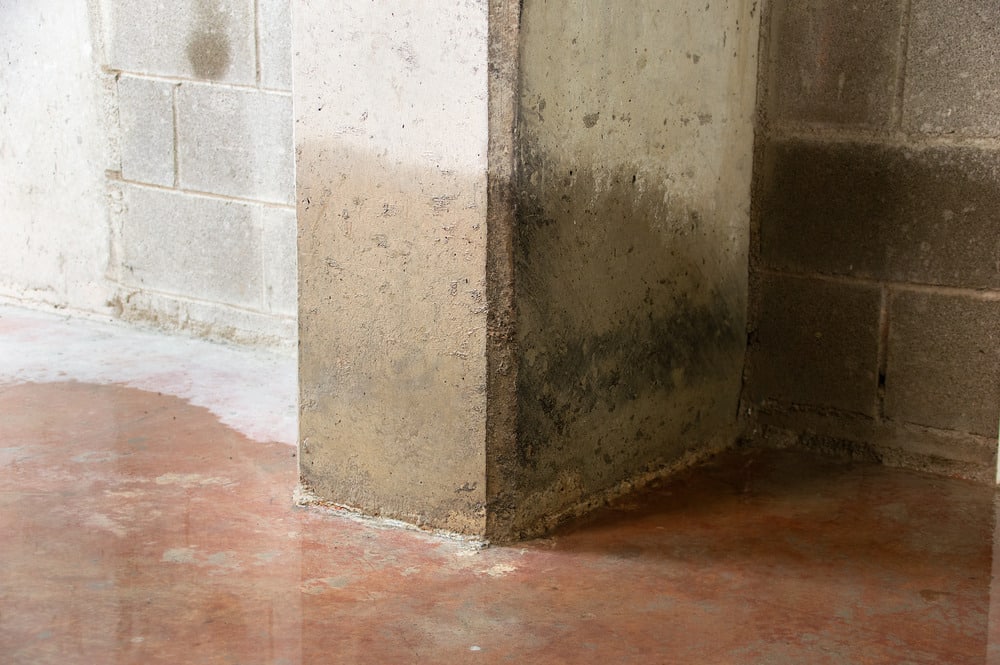A damp basement is a threat to your home’s long-term integrity and your family’s well-being. Water infiltration sets off a chain of issues that extend far beyond the initial moisture, affecting everything from the structural integrity of your house to the quality of air in your living spaces. The reality is, basement water problems don’t resolve themselves and only worsen over time without proper intervention. This guide provides comprehensive information on how to prevent water from entering your basement, and professional solutions to maintain a dry, safe foundation beneath your home.
Common Causes of Basement Water Problems
Most basement water problems occur when water can’t drain properly or when the barriers that should keep water out start to fail. That said, here’s what typically causes water to end up in your basement:
Poor Exterior Drainage
Rain and melted snow need a clear path away from your house so they don’t flood your basement. Gutters that are cracked, sagging, or filled with leaves can’t do their job and move water safely off your roof. When downspouts dump water too close to your foundation, it soaks into the ground right next to your basement walls. All these drainage problems work together to send water toward your basement instead of away from it.
Foundation Cracks
Every house settles as it gets older, and this natural movement creates small cracks in the basement walls and floors. Cold winters and hot summers cause concrete to expand and shrink, which gradually widens these cracks over time. Even tiny cracks give water a way to get inside during heavy rains or when groundwater levels rise after storms.
Faulty or Absent Waterproofing
Many homes were built without proper waterproofing systems that could prevent water from entering through the basement walls. Construction workers sometimes use cheap materials or apply waterproofing systems incorrectly, which causes them to fail much sooner than they should. Without effective waterproofing, water slowly works its way through concrete and finds the easiest path into your basement space.
High Water Tables and Groundwater Seepage
Groundwater is always moving through the soil, and it naturally flows toward the lowest areas, like your basement. Houses built near lakes, rivers, or in low spots deal with more groundwater pressure than homes on higher ground. Spring rains and melting snow can raise underground water levels and saturate the soil around your basement walls. The type of soil around your house affects how long water stays in the ground after storms. Professional contractors can install systems that redirect this underground water before it creates enough pressure to affect your foundation.
Plumbing Leaks
Old pipes in your basement can develop small leaks that you might not notice right away, but still cause moisture problems. Water pipes and sewer lines can crack where they connect to each other, letting water seep out into the surrounding area. Sometimes what looks like a pipe leak is actually just condensation forming on cold pipes when warm air hits them.
Hydrostatic Pressure
Wet soil around your house can push against your basement walls with a lot of force. After big storms, this pressure builds up as more water collects in the ground around your foundation. The constant pressure eventually forces water through tiny holes in concrete or through cracks that are too small to see. This pressure can even crack your basement floor or walls if it gets strong enough.
Improper Landscape Grading
The way your yard slopes determines where water goes when it rains, and if your yard is not graded negatively, water will be directed toward your house instead of away from it. The soil around your foundation settles over time and creates low spots that collect water right against your basement walls. Patios, sidewalks, and driveways that don’t slope properly can also direct water toward your foundation.
Condensation
Your basement is cooler than the rest of your house, so when warm air comes downstairs, it may cause condensation. Poor air movement means this humid air gets trapped and can’t escape, causing water droplets to form on the walls and pipes. Activities like cooking, showering, or doing laundry add even more moisture to the air in your basement.
Sump Pump Failure
Sump pumps work hard to remove water from around your foundation, but they can break down when you need them the most. Power outages during storms leave your pump unable to work right when water levels are at their highest. Pumps can burn out over time, or they can get clogged with debris, preventing them from pumping properly.
Basement Window Problems
Windows below ground level face extra challenges because they’re surrounded by saturated soil. Old window frames made of wood or metal rot and rust over time, creating gaps where water can leak through. Window wells that don’t drain properly collect water during storms and put pressure on window seals until they give way.
Interior Moisture Sources
Certain routine activities in your basement can create water vapor that adds to humidity problems throughout the space. Clothes dryers that aren’t vented outside dump moist air directly into your basement, where it condenses on cool surfaces. Bathrooms and kitchens in finished basements produce steam that needs proper ventilation to prevent moisture buildup. Even new concrete in recently built homes contains water that takes a long time to dry out completely.
Signs You Have a Basement Water Problem
Below are the main signs that water is leaking into your basement:
Musty Odors
A sour, stale smell in your basement often provides the initial sign that moisture has entered your space and created conditions for bacterial growth. This distinctive odor develops in areas where dampness exists without proper air circulation or drying. The smell gets worse during rainy weather when more water penetrates through small cracks in your foundation. Once this distinctive scent appears regularly, it means that water has been present long enough to start causing problems.
Water Stains on the Walls or Floor
Dark stains on the basement walls and floors tell you exactly where water has been slowly penetrating through your foundation over the years. These discolored areas start small but gradually expand if the moisture problem isn’t addressed. You’ll also notice white, chalky patches called efflorescence that appear when water dries and leaves behind mineral deposits from dissolved salts. This powdery substance typically develops near cracks, joints, and porous concrete areas where water activity is most common.
Damp or Buckling Flooring
Floors that are bouncy or sag visibly show that water has seeped through the materials underneath and weakened them. Wood floors may have gaps between the planks or start buckling on the edges when moisture makes them expand and contract repeatedly.
Increased Humidity Indoors
Thick, damp air in your basement creates an uncomfortable environment that’s unlike the rest of your house. This extra moisture causes water droplets to form on cold surfaces like pipes and concrete walls throughout the room. If your basement consistently feels damp or humid, excess humidity from water problems is affecting the entire area.
Preventive Measures to Keep Your Basement Dry
Water prevention in basements becomes a lot easier when you take care of issues before they arise, rather than dealing with expensive repairs afterward. The best tips to enjoy a consistently dry basement are as follows:
Improve Exterior Drainage
Effective water management starts by directing moisture away from your home’s foundation before it can cause problems. Keep gutters free of leaves and debris so water flows properly through downspouts that extend at least four feet from your house. Shape the ground around your foundation so it slopes away from your home, allowing rainwater to flow naturally toward drainage areas. Installing French drains provides extra protection by collecting groundwater and channeling it safely away from your basement walls.
Seal Cracks and Gaps
Foundation cracks allow water to enter directly into your basement during storms and heavy rainfall. To prevent water from coming into the basement spaces, seal cracks yourself or have them professionally sealed.
Avoid Storing Wet Items in the Basement
Bringing damp clothing, wet equipment, or recently washed items into your basement adds unnecessary moisture to the air. So, store only completely dry items in basement areas to prevent humidity buildup.
Fix Leaky Pipes and Plumbing Fixtures Promptly
Basement pipes and appliances need regular inspection because even small leaks create significant moisture problems over time. Check your water heater, washing machine, and all visible plumbing.
Consider a Battery Backup for Your Sump Pump
Your main sump pump may fail during power outages when you need it during harsh weather. Battery backup pumps automatically take over when primary systems stop working or lose electricity. Install backup systems that match your basement’s water removal needs for reliable protection.
Ensure Your HVAC System is Properly Sized and Maintained
Extending your heating and cooling system into basement areas improves air circulation and helps control moisture levels year-round. Properly sized HVAC equipment prevents humidity problems caused by inadequate air movement or poor temperature control. Change the air filters regularly and seal any ductwork leaks to maintain system efficiency.
Professional Solutions for Basement Water Problems
Let’s explore the main basement water problem solutions that experts use to fix persistent dampness problems:
Interior Waterproofing Systems
Interior waterproofing collects water that enters your basement and diverts it before it can damage your items or building. Waterproofing experts install drainage channels around your basement’s perimeter that collect moisture as it seeps in through the foundation walls. The collected water flows to a central sump pump system that forces it away from your home through buried discharge lines. This works effectively because it addresses water at the point where it most often creates problems. If you’re dealing with water appearing on your basement floor during storms, interior systems provide reliable protection without requiring major excavation around your property.
Crack Injection and Foundation Repair
Foundation cracks are direct entry points for water intrusion into your basement and must be correctly sealed against future penetration. Cracks sealed with epoxy or polyurethane foam are a great short-term fix, but can fail after continued wall movement. For a long-term fix, or for larger or leaking cracks, they may install a PVC patch that redirects water to a drainage system.
Install or Upgrade Sump Pump
Sump pump systems drain water that’s built up in your basement before it has a chance to spread and cause flood damage. The system connects to perimeter drains that channel water from problem areas straight to the sump basin. If you use battery backup units, they protect your home during power outages when severe weather creates the highest risk of flooding.
Final Thoughts
When water finds its way into your basement through damaged foundation walls or poor drainage, it causes mold growth and structural problems that worsen with each passing year. The musty smells and wall stains you notice today will turn into expensive foundation repairs if they are not resolved. Bluebird Foundation Repair and Waterproofing solves these water problems with interior waterproofing, drainage systems, sump pump installation, crawlspace waterproofing, and foundation repair. Contact us today for a free inspection and get the professional waterproofing services that will keep your basement clean, dry, and healthy.





